ICND1 – IP Routing
[am4show have=’p2;’]
Premium Member: You can test your knowledge with these questions first via this link.
[/am4show]
Note: The ICND1 exam requires candidates to understand basic knowledge of dynamic routing protocols (RIP, EIGRP, OSPF).
Question 1
[am4show have=’p2;’]What is the best practice when assigning IP addresses in a small office of six hosts?
A. Use a DHCP server that is located at the headquarters.
B. Use a DHCP server that is located at the branch office.
C. Assign the addresses by using the local CDP protocol.
D. Assign the addresses statically on each node.
Answer: D[/am4show]
Question 2
[am4show have=’p2;’]The ip helper-address command does what?
A. assigns an IP address to a host
B. resolves an IP address from a DNS server
C. relays a DHCP request across networks
D. resolves an IP address overlapping issue
Answer: C[/am4show]
Explanation
By default, Cisco routers do not forward broadcast address. So what will happen if your PC does not in the same LAN with DHCP Server? Your PC (also a DHCP Client) will broadcast a packet but it is dropped by the router -> Your PC cannot get the IP from DHCP Server. So the “ip helper-address” command enables the DHCP broadcast to be forwarded to the DHCP server. For example, the IP address of your DHCP Server is 10.10.10.254 then we can type in the interface connecting with the DHCP Client (fa0/0 in this case) this command: “ip helper-address 10.10.10.254”.

Note: When a client boots up for the first time, it transmits a DHCPDISCOVER message on its local physical subnet. Because the client has no way of knowing the subnet to which it belongs, the DHCPDISCOVER is an all-subnets broadcast (destination IP address of 255.255.255.255, which is a layer 3 broadcast address). The client does not have a configured IP address, so the source IP address of 0.0.0.0 is used.
Question 3
[am4show have=’p2;’]Refer to the exhibit. As packets travel from Mary to Robert, which three devices will use the destination MAC address of the packet to determine a forwarding path? (Choose three)
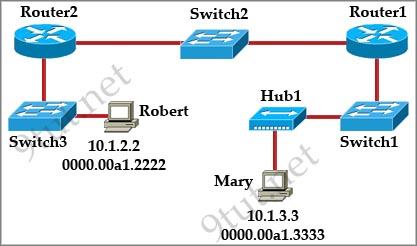
A. Hub1
B. Switch1
C. Router1
D. Switch2
E. Router2
F. Switch3
Answer: B D F[/am4show]
Explanation
Routers do not look to the destination MAC address to forward packet. It will find the next destination MAC address itself to replace the old destination MAC address of the received packet.
Hubs do not care about MAC addresses, it just flood the frames out of all its port except the port that sent it.
Therefore only three switches in the exhibit above use destination MAC address to determine the next hops.
Question 4
[am4show have=’p2;’]Refer to the exhibit. HostX is transferring a file to the FTP server. Point A represents the frame as it goes toward the Toronto router. What will the Layer 2 destination address be at this point?
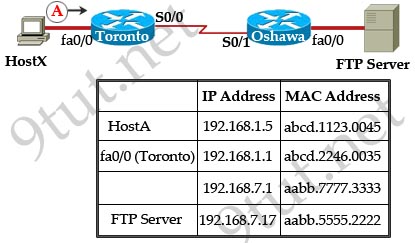
A. abcd. 1123.0045
B. 192.168.7.17
C. aabb.5555.2222
D. 192.168.1.1
E. abcd.2246.0035
Answer: E[/am4show]
Explanation
The destination MAC address at point A must be the MAC address of the interface fa0/0 of Toronto router -> E is correct.
Question 5
[am4show have=’p2;’]The command ip route 192.168.100.160 255.255.255.224 192.168.10.2 was issued on a router. No routing protocols or other static routes are configured on the router. Which statement is true about this command?
A. The interface with IP address 192.168.10.2 is on this router.
B. The command sets a gateway of last resort for the router.
C. Packets that are destined for host 192.168.100.160 will be sent to 192.168.10.2.
D. The command creates a static route for all IP traffic with the source address 192.168.100.160.
Answer: C[/am4show]
Explanation
The simple syntax of static route:
ip route destination-network-address subnet-mask {next-hop-IP-address | exit-interface}
+ destination-network-address: destination network address of the remote network
+ subnet mask: subnet mask of the destination network
+ next-hop-IP-address: the IP address of the receiving interface on the next-hop router
+ exit-interface: the local interface of this router where the packets will go out
Therefore the purpose of this command is to send any packets with destination IP address in the range of 192.168.100.160/27 subnet to 192.168.10.2. In fact, answer C is a bit weird when saying “host 192.168.100.160” because 192.168.100.160 is the network address in this case and it cannot be assigned to a host. But answer C is the most suitable answer for this question.
Question 6
[am4show have=’p2;’]What does administrative distance refer to?
A. the cost of a link between two neighboring routers
B. the advertised cost to reach a network
C. the cost to reach a network that is administratively set
D. a measure of the trustworthiness of a routing information source
Answer: D[/am4show]
Question 7
[am4show have=’p2;’]Refer to the exhibit. If host A sends an IP packet to host B, what will the source physical address be in the frame when it reaches host B?
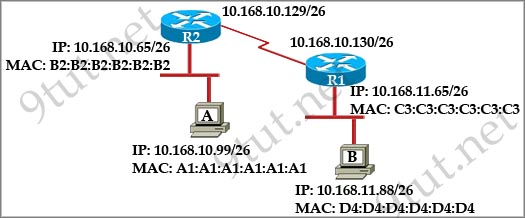
A. 10.168.10.99
B. 10.168.11.88
C. A1:A1:A1:A1:A1:A1
D. B2:B2:B2:B2:B2:B2
E. C3:C3:C3:C3:C3:C3
F. D4:D4:D4:D4:D4:D4
Answer: E[/am4show]
Explanation
After receiving a packet, the router will keep the source and destination IP addresses while change the source MAC address (to the MAC address of its outgoing interface) and the destination MAC address (to the MAC address of the next-hop interface). Therefore when the packet reaches host B, the source MAC address must be the MAC address of the outgoing interface of R1.
Question 8
[am4show have=’p2;’]Refer to the exhibit. Host A is sending a packet to Host B for the first time. What destination MAC address will Host A use in the ARP request?
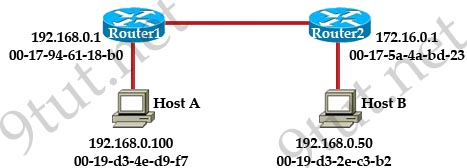
A. 192.168.0.1
B. 172.16.0.50
C. 00-17-94-61-18-b0
D. 00-19-d3-2d-c3-b2
E. ff-ff-ff-ff-ff-ff
F. 255.255.255.255
Answer: E[/am4show]
Explanation
Host A knows the IP address of Host B but it does not know the MAC address of host B, so it have to create an ARP Request (which is a broadcast frame) to ask for the MAC address of host B. When Router1 receives this ARP Request, it answers with its own MAC address.
Question 9
[am4show have=’p2;’]Refer to the exhibit. Host A can communicate with Host B but not with Host C or D. How can the network administrator solve this problem?
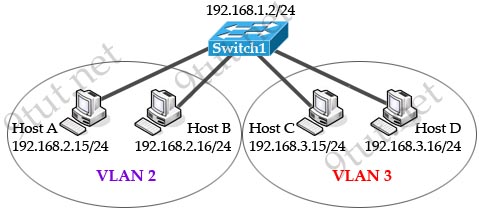
A. Configure Hosts C and D with IP addresses in the 192.168.2.0 network.
B. Install a router and configure a route to route between VLANs 2 and 3.
C. Install a second switch and put Hosts C and D on that switch while Hosts A and B remain on the original switch.
D. Enable the VLAN trunking protocol on the switch.
Answer: B[/am4show]
Question 10
[am4show have=’p2;’]Refer to the exhibit. The host in Kiev sends a request for an HTML document to the server in Minsk. What will be the source IP address of the packet as it leaves the Kiev router?
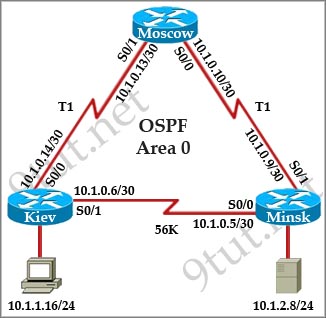
A. 10.1.0.1
B. 10.1.0.5
C. 10.1.0.6
D. 10.1.0.14
E. 10.1.1.16
F. 10.1.2.8
Answer: E[/am4show]
Explanation
Along the routing path, the source and destination IP address will not change so the source IP will always be 10.1.1.16.


Question 5, answer C.
It should not read host. That IP address is a subnet ID and cannot be assigned to a host.
Host should be replaced with the word subnet, or network.
If someone sees this, why is the answer to question 9, B? Why can’t it be D, enable VLAN trunking? THanks
@testingsoon
VLAN trunking does not route between VLANs, it only passes the traffic between switches on which the trunk is set up.
The VLANs are each on their own subnets, and a layer 2 switch cannot route between different subnets. Thus, you need a router to route the traffic between the two
Reference #9, this is what Cisco calls ‘Router on a stick’….setting up a router just to route between different VLANS on a switch.
Anyone,
I plan on taking exam next week. What other sims/labs did you get besides the OSPF 6 router?
Thanks in Advance!
Hi 9tut,
I think Q8 answer should be C. 00-17-94-61-18-b0, not E. ff-ff-ff-ff-ff-ff. Am i right?
@Mason: Q8 answer is E because Host A knows the IP address of Host B but it does not know the MAC address of host B, so it have to create an ARP Request (which is a broadcast frame: FF-FF-FF-FF-FF-FF) to ask for the MAC address of host B first.
@ 9tut
I do appreciate for your great job.
we should keep this site up even with a small donation.
@testingsoon
The answer is not D because the switch used in this exhibit is not a Layer 3 switch. I think Cisco uses a different image for Layer 3 switch. And only Layer 3 switches have routing capability.
i am preparing my ICND1 exam, the explanation of question 2; the ip helper-address will be on conf mode or the interface mode?
——————————–
testingsoon
December 19th, 2013
If someone sees this, why is the answer to question 9, B? Why can’t it be D, enable VLAN trunking? THanks
——————————–
Trunking is used in between switches.
We would need routing between 2 vlans, so 2 seperate ip subnets too.
1 way to achieve this is a router (Router On A Stick in this situation)
second way is to implement L3 intervlan routing, by using L3 capable switch.
Am i wrong? 🙂
Q9 is correct, I just tried it via packet tracer. 192.168.2.x and 192.168.3.x are on different subnets so without routing they should not be able to talk. The trunking may work on a layer 3 switch but the one in the picture is a layer 2 device and layer 2 is only concerned with physical addressing and you would need logical support to get this to work. Given the answers supplied I do believe the correct answer would be the Router on a Stick approach.
I test in a couple days and I feel very good given these questions. I hope I finally knock this out!
Shouldnt question 8 be C. According to the diagram it knows its destination IP address and not its MAC Address, so it will forward it to its default gateway router 1. Once it gets to R1, R1 identifies it isnt its IP address, then replaces its mac then forwards to R2
DCMainiac I think it goes like this: PC looks at dest. IP and it’s subnet mask, realizes other PC is on a different subnet – then it ARPs for MAC of its default gw. So, in reality it doesn’t ARP for host B MAC but for its def gw MAC.
@DCMainiac,
if host sends ARP request for getting MAC of default-gateway it means that in its arp-cache MAC of gateway doesnt exist.And host uses broadcast L2 address as destination:
arp request:source IP:IP of hostA,destination IP:IP of gateway,source MAC:MAC of hostA,destination MAC:FF:FF:FF:FF:FF:FF.
Hello Every one
Please send me vce file to open dump on my email rafaqat_edu@yahoo.com
Either router on a stick or L3 switch should be used to route the traffic between two vlans period, without routing mechanism you have no communication between the vlans each vlan is a separate broadcasting area this is how vlans works ;).
Guys you should get free dumps and many other helping materials from [ http://adf.ly/o7ba3 ]
Its a direct and safe download and the download speed is ultra high.
Also the dumps is super easy to download.
Enjoy.
Please share more if you’ve different questions and you took 100-101 recently. Thanks
Q1 – In this day & age, with mobile devices such as laptop computers so prevalent, I don’t think static addresses are appropriate any more. If you want fixed addresses for users, just configure the DHCP server to do that. Also, with today’s routers, a DHCP server is almost always available. With IPv6, this issue doesn’t even arise, as there are 2 methods, MAC address and random number, for setting an address, though DHCP and static configuration are still available.
Q8 – “Host A knows the IP address of Host B but it does not know the MAC address of host B, so it have to create an ARP Request (which is a broadcast frame) to ask for the MAC address of host B. When Router1 receives this ARP Request, it answers with its own MAC address.”
That is absolute nonsense. Host A will look at the destination address and compare it with the network it’s on. If it determines the address is not on the local network, it will send the packet to the router. It will first do an ARP request for the router’s MAC address, if it doesn’t already know it. The router couldn’t possibly send it’s MAC address to that request, because that request would never happen.
@JamesK: exactly…. I thought nobody was going to mention that.
When host A sends a broadcast to get the MAC address for host B, the router would drop that packet imediately. Which host A would never do because it knows it is on another network.
Therefor Host A will send the broadcast to get the MAC address of the router. Then finally Host A will send the packet to host B with the Destination MAC address of the router.
qs 8 answer should be C ?
@Anonymous
No, the answer, despite the nonsense explanation is E. Arp requests are broadcasts, so they go to MAC address ff-ff-ff-ff-ff-ff. Since B is not on the same network as A, A forwards the packet to the router. However, if A doesn’t know the MAC for router 1, it will do an arp request for the router’s MAC. The router will never respond to a arp for B.
Will there be any questions related to ACL and IPv6 on ICND1 exam? answers appreciated
Question 5
.160 is the network address, not host address. That IP address is a subnet ID and cannot be assigned to a host. Host should be replaced with the word subnet, or network or there is no correct answer.
The answer to question 8 is C due to proxy arp being enable by default on CISCO routers…
Whoops, sorry, it would help if I read the question carefully. I read it as what would the router use, not Host A for the initial request.
Questions 1-2-6-9 were in exam on 20/11/2014, more than 45 questions were from 9tut !
testingsoon:
If someone sees this, why is the answer to question 9, B? Why can’t it be D, enable VLAN trunking? THanks.
It is B because a a trunk can only be setup between switch to switch or switch to router.
In this scenarios, we will use a router with two subinterfaces (one for each vlan) and run a trunk port from the router to the switch. The router will receive traffic from vlan 2 and send it back down the trunk to vlan3 and vice versa.
@ Vahid, and @9tut Although the default route makes sense that anything destined for that subnet should go to the next hop address, Vahid is correct in the syntax and that shouldn’t say “Host” on the answer to Q5, rather it should say “…packets destined for network…”.
regarding Q4 I don’t quite agree with the answer, it says in the question what the MAC address will be at this point A, which means the packet hasn’t reached the fa0/0 port yet, so it should still be the host’s MAC not the fa0/0, the MAC address only change when it go through the router, is that correct? many thanks!
@John, the source MAC address will indeed be the host, but the question asks for the destination MAC address, which will be the Fa0/0 port of the Toronto router
q1,2,8,9 in icnd1 exam
hi guys Q 2,6 and 9 were in the exam
Q 1,2,4,5 (answer C),6,8,9 in exam
HI! Could someone PLEASE send me the latest ICND1 dumps? THANKS evansj51@yahoo.com
@all: We had to move all the questions and answers out of 9tut. We can only keep the explanation. You can download the questions and answers at: https://mega.co.nz/#!oIdESYbD!yyu33vygrfKPy4rcmcbV6qW2fxINNoTokuDM3CjA_og
Where are the questions? I see the explanation, but not the actual code question
Where are the questions? I see the explanation, but not the actual questionion
Hi 9tut are these still up todate
Hi 9tut are these still up todate
Is there is any ACL question in ICND-1 ? please comment
I’m also curious if there are any ACL related questions in the first exam?
Send me link to download packet tracer for free.
Question: 10
Wouldn’t the source IP address changed if NAT is involved? As it leaves Kiev, the Kiev router would replace the source IP and please it’s own IP address which is 10.1.0.6.
Please help 🙁
exhibits of the questions are not showing, admin please fix this , thanks
Hi Can you help me with the correct answer for this question, got to different answer, is it A or C?
After you configure a default route to the Internet on a router, the route is missing from the routing table. Which option describes a possible reason for the problem?
A. The next-hop address is unreachable.
B. The default route was configured on a passive interface.
C. Dynamic routing is disabled.
D. Cisco Discovery Protocol is disabled on the interface used to reach the next hop.
I believe is A @lestat
Hello every one!
I can only see the answers and i am not able to see the question part. some one can help please?
hi guys,
can someone send me the dumps according the answers of this site for ICND1???? please please please. I really neeeeeeeeeeeeeeeed it. my email address is jane_woken52 at yahoo dot com . It will be big help. Pleeeeeeeeeeeeeeeease .
my email address is jane_woken52 @ yahoo . com
Unable to see questions, only answers, even on premium.
@Dan: If your problem still exists, please send an email to support@9tut.net with your username so that we can help you.
I think question 8 is E:, but read this article and see what you think.
https://www.quora.com/Why-is-the-ARP-packet-transmitted-before-the-ICMP-packet-in-Packet-Tracer
Terrific activity upon the compose up! I expect toward view read through added towards by yourself!
dftge454sws.com
Hi Every one i need your help the correct answer on this question.
1. Network topology, 2. R1 Running configuration, 3. R2 Running configuration
Your Company has decided to connect the main office with other remote branch office using point-to-point serial links. You are required to troubleshooot and resolve OSPF neighbor adjacent issues been the main office and the routers located in the remote branch office. R1 does not from an OSPF neighbor adjacency with R2. Which option to pix this issue
1. R1 e0/1 is down configure no shutdown command
2. R1 e0/1 configure with a non-defaulth OSPF hello interval of 25. configure no ip OSPF hell-interval 25
3. R1 e0/1 and R3 e0/0 are configured with a non-default OSPF hello interval od 25, configure no ip OSPF hello-interval 25
4, Enable OSPF for R1 e0/1, configure ip OSPF 1 area 0 command under e0/1.
Answ : ?
Please be kind and share icnd1&2 dumps tlbh05 at yahoo thank you
Does anyone have the dumps for ICND1?
I see only the explanations.
Please, send it to fbecatini @ gmail . com